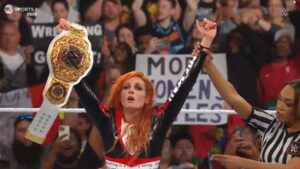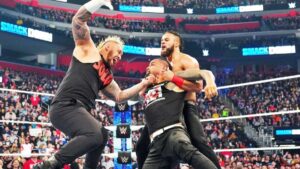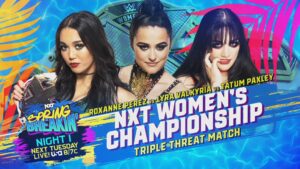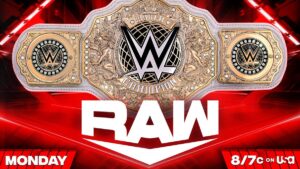On December 2, history was made on AEW Dynamite. Not only did Kenny Omega defeat AEW World Champion Jon Moxley to become All Elite Wrestling (AEW)‘s new World Champion, but he did it with the help of guest commentator Don Callis – who also happens to be an Executive Vice President with IMPACT Wrestling. Following the victory, Omega and Callis left the building, announcing to AEW’s viewers to follow the story to next Tuesday on AXS TV, home of Callis’ company’s flagship show, IMPACT! Wrestling. Thus, interpromotional activities began.
Tuesday, December 8’s episode of IMPACT! didn’t disappoint, as the show closed with a scathing promo from Callis and finally Omega, revealing their nearly three-decade plan to push Omega to the apex of the professional wrestling world, including capturing the AEW World Championship. They also revealed they would be back on AEW Dynamite on Wednesday night, while Omega himself would tease possibly acquiring the IMPACT World title to add to his collection. To add intrigue to the burgeoning AEW vs IMPACT collision, AEW owner Tony Khan and AEW announcer Tony Schiavone would also appear on Tuesday’s IMPACT!, in a “paid advertisement” where Khan made it clear he was not amused by the actions of Omega and Callis – he even went so far as to mention he may be scouting tag teams in IMPACT. A new interpromotional conflict had begun.
The emergence of an interpromotional rivalry via storyline proved to be big dividends for IMPACT Wrestling – on its Twitch channel, IMPACT! is regularly viewed by approximately 8,000 fans each week, but this past Tuesday ballooned to over 50,000 viewers thanks to Omega’s presence. At one point, IMPACT Wrestling was trending #1 on Twitter. Suddenly, the pro wrestling world was abuzz. AEW and IMPACT were not known to be in any sort of backstage alliance, despite Callis having appeared once before in a previous guest commentary role and several IMPACT talents appearing on AEW Dynamite early in AEW’s existence due to multiple contracts. The kind of interpromotional interactions – invasions of bravado territorial pissing contests, between two promotions not well-publicized to be in business relations – have been part of the wrestling fabric since the 1980s.
They’ve been so successful that “invasion angles” have become well-used tropes used by illusions to other promotions invading (such as the nWo suggesting a WWE takeover in 1996 in WCW or Los Invasores hinting that they were invading CMLL from AAA, when in reality both factions were signed to the invaded companies) to internal invasions from seemingly outside radicals (like WWE’s Alliance Invasion, NXT’s Nexus onto Raw, or the current RETRIBUTION storyline in WWE). There have been plenty of interpromotional showcases. For years, in the territories, it wasn’t unusual for top champions to compete in showcase champion vs. champion matches. There still exist interpromotional alliances today that often has matches against each other, like the IWGP Connection of New Japan Pro Wrestling (NJPW), Ring of Honor, and CMLL, but these are matches are born out of mutual respect, not vitriol. Here’s a look at some of the top “invasion” angles that involved two independently owned promotions based on hostile intentions.
ICW vs. CWA, 1983-1984
In 1978, Angelo Poffo created International Championship Wrestling (ICW) and the outlaw promotion – due to its refusal to align with the National Wrestling Alliance (NWA) – put it in direct competition with several NWA territories, initially against Ron Fuller‘s Southeastern Championship Wrestling (SCW) in Knoxville, Tennessee. As ICW grew in Tennessee, it inevitably began to compete against Memphis’ Continental Wrestling Association (CWA), owned by Jerry Jarrett and Jerry “The King” Lawler.
The rivalry took on a new level when IWC’s rising young star, “Macho Man” Randy Savage, began working in CWA against Lawler in late 1983, and defeating Terry Taylor for the NWA Mid-America Heavyweight Championship that December. While ICW’s invasion brought several ICW stars into CWA to fire up the crowds, behind the scenes, things weren’t so equal. By early 1984, ICW was losing money and Angelo Poffo folded the company. Lawler and Jarrett bought out ICW and pushed the interpromotional invasion storyline further for a while longer (before the public ever realized ICW had shut down) before the stars were just integrated into CWA. Savage would just hit his stride in CWA before jumping to the WWF in 1985.
JPW vs. AJPW, 1984
In 1984, a disgruntled Riki Choshu left NJPW after spending a decade with the company and formed his own promotion, Japan Pro-Wrestling (JPW). He took with him his stable, Ishin Gundan, which featured the likes of Animal Hamaguchi, Masa Saito, Kuniaki Kobayashi, and Yoshiaki Yatsu, who at the time were arguably New Japan’s hottest faction. They became the principal stars of JPW and behind the scenes, JPW signed an alliance with NJPW’s rivals, All Japan Pro Wrestling (AJPW).
Ishin Gundan immediately began to invade AJPW and attack many of All Japan’s top stars for much of 1984 and 1985, before the alliance became public and the two promotions co-promoted events together. But in the early year of the interpromotional alliance, most fans were under the assumption that these former New Japan renegades were truly invading AJPW. Choshu canceled the partnership in 1987 and soon after, folded JPW. He would return to New Japan where he would go on to become a 3x IWGP Heavyweight Champion.
WWF vs. USWA, 1993
In 1989, in an effort to avoid to combat the rise of giants like the WWF and WCW, CWA and Texas’ World Class Championship Wrestling (WCCW) would merge to form United States Wrestling Association (USWA). In 1992, the USWA signed a talent exchange agreement with the WWF (essentially becoming a developmental for WWF), which lead to Memphis’ biggest star, Jerry “The King” Lawler, finally signing with Vince McMahon and the WWF. Initially starting as an announcer on WWF Superstars, by early 1993, he was in the ring, leading to Lawler attacking Bret “Hitman” Hart after winning King of the Ring. Declaring himself the only true “King” in pro wrestling, USWA’s 27x Unified World Heavyweight Champion would engage in a lengthy feud with Bret and the entire Hart Family. This was just the first true shot.
The feud would escalate across promotional lines when Vince McMahon arrived in Memphis in 1994 and immediately began a feud with Lawler back in USWA. It would create the earliest blueprints for Vince’s Mr. McMahon character – Lawler (who was a heel in WWF) was still USWA’s biggest babyface and McMahon – who was a face commentator still in WWF and had yet to be publicly revealed as WWF’s owner on WWF television – was the hated heel. McMahon even openly admitted to being WWF’s owner on USWA television, on a quest to shut down the Memphis territory and become Memphis’ true “King of Wrestling”. In his feud, McMahon brought Bret Hart, Owen Hart, Randy Savage, Tatanka, and others to USWA to do his dirty work. While it proved a good boost for USWA, WWF never mentioned the entire feud once on WWF programming, so it was entirely one-sided.
NJPW vs. UWFI, 1995
Much like JPW, other disgruntled NJPW wrestlers who departed in 1984 also formed their own promotion with the Universal Wrestling Federation (UWF). The UWF became an early blueprint for promotions like Pancrase and early pioneers of MMA, as it incorporated more martial arts and submission/catch wrestling into its repertoire than that of NJPW. The promotion folded in 1990, but several of the members rebooted the company a year later, this time as UWFi (Union of Wrestling Forces International), keeping it’s more physical style. By 1995, UWFI was fading once again and began a working agreement with NJPW. This lead to a UWFi invasion of New Japan, with their more MMA/shoot style wrestlers taking on New Japan’s stars.
But one of the provisions of New Japan agreeing was that NJPW would have 100% booking control over the interpromotional angle – at the time, New Japan’s President was Riki Choshu (who himself had run the invasion of JPW into NJPW a decade earlier), and New Japan ended up squashing UWFI in most of the match-ups. The only UWFi star that shone was former IWGP Junior Heavyweight Champion Nobuhiko Takada, who defeated Keijo Mutoh (The Great Muta) himself to become IWGP Heavyweight Champion during the cross-promotional war, holding it for 116 days. Their alliance with NJPW ended in 1996 and the company tried to recreate another invasion, this time with Genichyro Tenryu‘s Wrestle Association R (WAR), but it failed – UWFi would fold in December of 1996. While the invasion angle didn’t help UWFi from rebuilding itself, it did have an important part in pro wrestling history – at the same time, New Japan was also in an alliance with US major promotion WCW, and Eric Bischoff happened to catch the invasion show. He would adopt the idea for his own promotion, creating the nWo in the UWFi invasion force’s image.
https://www.youtube.com/watch?v=8tKp89DMWzA
ECW vs. WWF, 1996-1997
Vince McMahon would go the interpromotional avenue once again in 1996 as the Attitude Era began to take fold; this time he allowed it (and started it) on WWF programming. By the middle of 1996, McMahon had become keenly aware of ECW’s rise as the top independent in the country – thanks to the ECW chants when WWF held King of the Ring in Philadelphia in 1995. At the WWF In Your House: Mind Games PPV in September of 1996 – also held in Philadelphia – McMahon invited several ECW stars to sit at ringside.
McMahon – then still an on-air commentator – mentioned ECW by name on the broadcast as an up-and-coming “local” and ECW stars like Taz, Sandman, and Tommy Dreamer sat at ringside, with Sandman throwing beer on WWF Superstars during a match. The following night on Raw, Taz and Bill Alfonso invaded the show. The following February in 1997, ECW launched a full-on “invasion” of WWF and Raw, with several ECW stars competing on the show, including Dreamer, Taz, and D-Von Dudley. This actually led to a three-promotion angle, as Jerry Lawler – still on commentary for WWF – verbally attacked ECW and led to an ECW-USWA invasion angle as well.
NWA vs. WWF, 1998
Vince McMahon seemed to be far more generous with interpromotional tie-ins in the 1990s than he was before (or since). After crossing over with USWA in 1994 and then ECW in 1996 and 1997, he allied with the NWA for the first time since the WWF seceded from the NWA back in 1983 (one year after Vince Jr. took over the company). In January of 1998, Jim Cornette appeared on Raw and announced that WWF Superstar Jeff Jarrett would fight against Barry Windham for the vacant NWA North American Heavyweight Championship.
After Jarrett won the title, Cornette and Jarrett proceeded to launch an NWA invasion of the WWF, with NWA World Tag Team Champions The Rock N’ Roll Express (Ricky Morton & Robert Gibson) joining the fold shortly after. The new NWA stable would later add Barry Windham and finally the reigning NWA World’s Heavyweight Champion Dan “The Beast” Severn. Sadly, by August of 1998, McMahon changed his mind on interpromotional alliances and abandoned the NWA invasion angle – after all, by the late 1990s, the NWA was no longer the all-powerful wrestling figurehead but a loose collection of independents in the US, with the rights to the NWA properties held by Robert Trobich (who bought the rights in 1989 and sold them to Bruce Tharpe in 2012, who in turn sold them to Billy Corgan in 2017).
CZW vs. ROH, 2006
The NWA experiment would prove to be WWE’s final collaboration with an independent promotion (although they’d incorporate it later with the “invasion” of NXT hopefuls Nexus in 2010 and RETRIBUTION in 2020), but once the indie wrestling revolution of the early 2000s kicked off after WCW and ECW folded in 2001, it wasn’t uncommon to see various indie promotions utilize each other to try and enhance the growing indie scene in the US. Two promotions who were part of the initial spearhead – Combat Zone Wrestling (CZW) and Ring of Honor – originally tried to work together in 2002 but nothing came of it. But in 2005, Bryan Danielson (now WWE Superstar Daniel Bryan) was ROH World Champion and he issued an open challenge to wrestlers of all promotions to defend his title. During his 462-day reign, Danielson defended against the likes of Pro Wrestling NOAH‘s Noamichi Marufuji, TNA’s Christopher Daniels and AJ Styles, and others.
However, in January of 2006, it was CZW’s Chris Hero who launched the interpromotional invasion of CZW into ROH when he challenged Danielson for the title at January’s ROH Hell Freezes Over event. Hero didn’t come alone either – he brought CZW stars Nate “Spyder” Webb, Necro Butcher, and Adam Flash (as well as CZW referee and now AEW ref Bryce Remsburg). The match had originally been called out at CZW Cage of Death 7 in 2005, which resulted in Danielson arriving at CZW’s An Afternoon of Main Events in January of 2006, accompanied by ROH’s Nigel McGuinness, Austin Aries, and Roderick Strong. The feud would flip-flop back and forth from CZW and ROH PPVs before ending at ROH War of the Wire II, when ROH’s BJ Whitmer defeated Butcher. At the time, both promotions were arguably of equal strength, but within a year or so from the feud, ROH would emerge as one of the top US indies on the planet, while CZW would delve further into the deathmatch niche.
NJPW vs. NOAH, 2015
While New Japan had also soured on invasion angles, they had for years done special event shows with other promotions, including utilizing various promotional talents for tournaments. But in 2015, NJPW sent its most vicious faction, Minoru Suzuki‘s stable Suzuki-gun to Pro Wrestling NOAH, with the stable spending an entire year poisoning and dominating the rival Japanese promotion. During their invasion, Suzuki-gun captured much of NOAH’s gold – Suzuki himself held the GHC Heavyweight title for 283 days, Taichi was GHC Junior Heavyweight Champion the same amount of time, Killer Elite Squad (Davey Boy Smith Jr. & Lance Archer) became 2x GHC Tag Team Champions, and El Desperado & TAKA Michinoku were GHC Junior Tag Team Champions for 203-days. In short, Suzuki-gun ran riot in NOAH for nearly two years. When NOAH and NJPW’s interpromotional partnership ended, Suzuki-gun returned to NJPW in January of 2017, but for two years one of New Japan’s most feared stables not only invaded a rival but dominated it.
GCW vs. CZW, 2017
In recent years, the US indies have seen a boom with far more accessibility than even the initial revolution of the early 2000s. Top indies in the US – and around the world – were finding the kind of lives on streaming services that could have potentially saved many earlier indies (and NWA territories) had the services been available. In 2017, once again, CZW was part of another invasion. This time, they were on the receiving end of it. In 2015, Brett Lauderdale had taken over Jersey Championship Wrestling (JCW) and rebranded it as Game Changer Wrestling (GCW) and the newly revisioned promotion had a new philosophy – it was incorporating the best of deathmatch wrestling (akin to CZW and IWA Mid-South) and combined it with the exciting indie styles of early ROH and PWG, to create a new US indie philosophy of anything goes.
Initially, the planned segment for CZW Cage of Death XIX in 2017 (12 years after CZW called their own shot at Cage of Death 7 in 2005 against ROH) was supposed to lead to a GCW vs CZW interpromotional invasion angle. However, real-life instances turned the segment into a shoot that ultimately only lasted one night. Since then, GCW has emerged as arguably the US indie scene’s top promotion. Meanwhile, CZW has continued to remain static in an indie scene they helped shape two decades earlier.
Stay tuned to the Last Word on Pro Wrestling for more on this and other stories from around the world of wrestling, as they develop. You can always count on LWOPW to be on top of the major news in the wrestling world, as well as to provide you with analysis, previews, videos, interviews, and editorials on the wrestling world. You can catch IMPACT Wrestling on Tuesday nights on AXS TV and Twitch.TV as well as all the time on IMPACT Plus. You can catch AEW Dynamite on Wednesday nights at 8 PM ET on TNT and AEW DARK Tuesday nights at 7 PM ET on YouTube.
Looking to talk wrestling, pro football, or any number of sports? Head on over to the LWOS Boards to engage in conversation with fellow fans!






